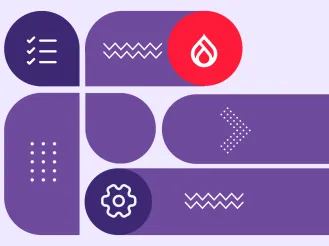Nonprofit and Higher Ed Marketers: 4 Ways to Use AI to Level Up Your Web Strategy
The whole world is talking about artificial intelligence. And you’ve probably played around with ChatGPT, Bard, and/or Bing to get a glimpse of what these tools can do. But if you’re like many time-strapped marketing leaders, you don’t have endless hours to spend trying to make AI work for you. After all, on any given day, there’s more work to do than you can handle — right?
Right. And that’s exactly why you need to figure out how to make AI work for you.
If you’re worried AI will take your job, don’t be. The human touch will always be needed, especially in the nonprofit and higher education sectors. But what AI will do is disrupt your industry (and potentially every other industry) in as-yet-undetermined ways.
Thankfully, with some thought and foresight, you can get ahead of the curve and position your organization to harness AI’s potential. Here are four practical ways to get started.
1. Give Users a Personalized Web Experience
Website personalization enhances user engagement by elevating content that’s most relevant to their interests and needs. By suppressing content that isn’t pertinent and replacing it with information that is, personalized website experiences can streamline the process of leading your audience through the decision funnel.
But for many marketers, lack of time is a significant barrier to actually creating the personalized experience they want users to have. Website personalization requires you to:
- Conduct in-depth persona research to understand your users better and document their user journeys.
- Collect and analyze copious amounts of data pertaining to your audience.
- Master a variety of CMS plugins such as Bootstrap Layout Builder to enable your CMS to pull the right levers for the right users at the right time.
AI can’t do all that work for you. But it can speed up the process and help you get to the heart of your users’ needs and wants more quickly. AI can:
- Analyze large volumes of data to create segments and personas based on demographics, behavior, preferences, and more.
- Predict user behavior and preferences based on historical data so you can anticipate your audience’s needs and give them the right information to nurture desired actions.
- Pull out salient audience sentiments by quickly reviewing feedback, reviews, and social media mentions and identifying patterns and trends.
All of this insight is crucial to creating a personalized web strategy designed to get results.
Furthermore, by adding API-integrated chatbots to the equation, you can create the feeling of a more customized, user-centered experience. Chatbots can offer personalized recommendations, answer questions, and otherwise strengthen your users’ self-service options.

2. Optimize SEO and Overall Website Performance
If you’ve been meaning to optimize your website but haven’t found the time, you’re in luck. AI-powered tools can help you quickly perform tasks such as detecting broken links, evaluating and improving website accessibility, and updating your keyword strategy. (Existing tools like Siteimprove can do some of this work now, but many platforms are developing AI solutions to do it faster and cheaper.)
AI can streamline some of the most tedious tasks of a marketer’s day and reduce the time it takes to:
- Conduct an SEO analysis and identify areas for improvement (e.g., page load speed, server response time, mobile-friendliness, keyword optimization).
- Audit and improve your content to enhance its search engine visibility.
- Perform keyword research and competitive analysis. In fact, AI-powered tools can generate keyword suggestions based on a given topic or seed keyword, look at historical search data and identify trends, and even analyze competitors' websites to discover the keywords they’re targeting.
- Ensure your website is meeting minimum standards of accessibility and serving the needs of all your users.
Of course, it’s important to note that while AI can be a valuable tool, it's still essential for you to have a good understanding of SEO principles and strategies. Yes, AI can automate and enhance certain aspects of SEO and site performance. But human expertise is crucial for interpreting insights, making strategic decisions, and aligning AI-driven recommendations with your broader marketing objectives.

3. Enhance Your Nonprofit or Higher Ed Website’s Design and UX
Your website's design — and the overall user experience (UX) it creates — can make or break your user engagement metrics. Why? Your design either propels users forward on their journey or hinders them from taking the actions you want them to take. Therefore, keeping your design engaging and user-focused is critical to achieving your marketing goals.
But you can’t do this in a vacuum. To make wise decisions about your design, information architecture, and navigation, you need insights and feedback from your audience. Unfortunately, the time it takes to wade through user research can be prohibitive. And it’s a common reason why marketers in nonprofit organizations and higher ed institutions don’t invest in user research the way they should.
Again, AI can help. Tools such as visualeyes, pecan.ai, and 3M’s vas are able to:
- Categorize and analyze audience feedback, pull actionable insights out of large data sets, and make appropriate design decisions based on what you find.
- Conduct scenario modeling to predict how your audience will interact with — and behave as a result of — various design options.
- Simulate the way your audience’s eyes will respond to your design so you can make adjustments to get the response you’re looking for.
- Create quick mock-ups of designs (logos, templates) to get feedback before investing time into refining and finalizing them.
By using AI, you can remove many obstacles that have previously prevented you from making data-driven design decisions.
4. Create Compelling Content
You shouldn’t use AI to write everything for you. If you do, your audience will be able to tell. Many AI outputs still sound formulaic, repetitive, and robotic. And they always lack nuance and a point of view. What’s more, AI is not entirely reliable. It can produce content that’s inaccurate and misleading. To that end, you can’t afford to risk losing your unique business voice and undermining your credibility by relying on AI too heavily.
So how should you use AI to create and edit content? There are plenty of viable options that will save you time and energy while keeping your audience firmly at the center of your content strategy. Here are a few ideas to get the ball rolling.
Make Existing Content More Readable
Higher ed institutions often fall into the trap of publishing long walls of text that sound like they were written by (or for) Ph.D. candidates. This can be hard for the average prospective student or site visitor to wade through. Along the same lines, nonprofit organizations sometimes cite in-depth research and other technical content in order to make their case for support. This waters down its impact and causes readers to tune out.
AI can distill complex information into digestible takeaways — allowing you to improve scannability and readability in the process. Just make sure you don’t lose any salient points or include any AI-generated “hallucinations” along the way. You still have to double check everything.
Brainstorm, Ideate, and Draft
Ask a tool like ChatGPT a few simple questions and it can easily:
- Generate topic ideas
- Put together a blog outline
- Write social media posts and emails
- Generate different versions of your messages to conduct A/B testing
- And more
Some resources like writer.com and jasper.ai can also generate first drafts of everything from blog posts to solicitation appeals. Again, it can’t do all the work for you, and you may end up using only a small percentage of the output AI generates. But if you’re having a hard time getting started on a writing assignment, AI is a fantastic resource to overcome the tyranny of the blank page.
Optimize Images and Videos
AI-powered tools can compress images without compromising quality, automatically generate alt text, and provide video transcription and tagging services. Making these changes will help your pages load faster, improve accessibility, and make a positive impact on SEO and site performance.
Just remember: You should proceed with caution when using AI to generate content (and when using it to improve your web strategy in general. First, you can’t be entirely sure the results you get are factually correct or original. Second, SERP algorithms could change to weight the value of human-created content over that generated by machines. And finally, companies are releasing new AI products and services every day. Do your due diligence to protect your organization’s reputation and operational well-being.
The Right AI Tools Can Be a Time-Strapped Marketer’s New Best Friend
To stay current and relevant, your web strategy must be future-focused and respond to change. That’s why you can’t afford not to use AI to optimize your organization’s web strategy. Using the right tools will enable you to reach a wider audience, personalize your outreach, and make smart data-driven decisions about your marketing techniques.
But don’t forget: While AI can automate certain tasks and provide valuable insights, you’ll always need to strike the right balance between automation and human expertise. AI can augment your capabilities and save you precious time. But there’s no substitute for your vision, imagination, and critical thinking skills. Only you can do the business-critical work of effectively leading your organization forward.







